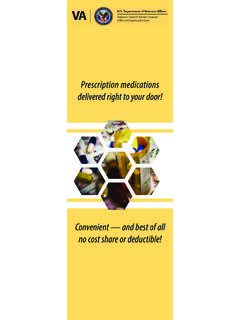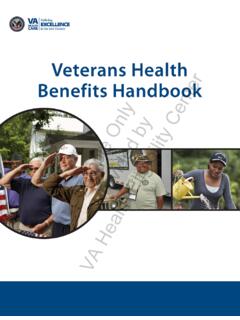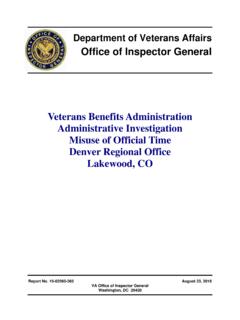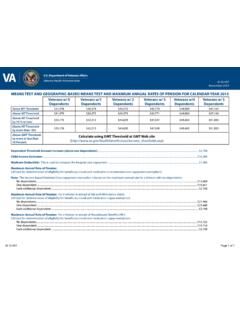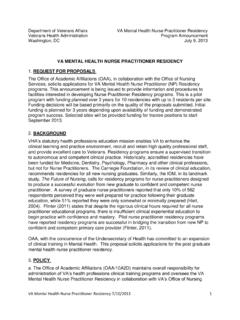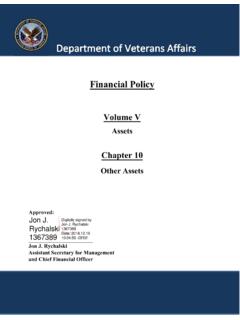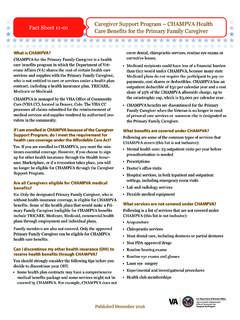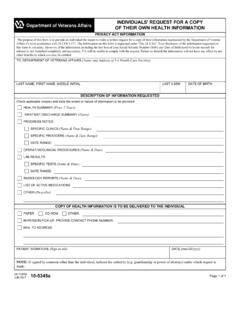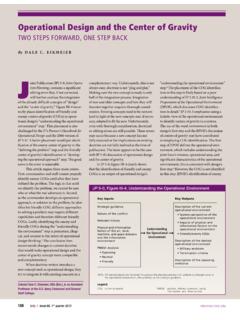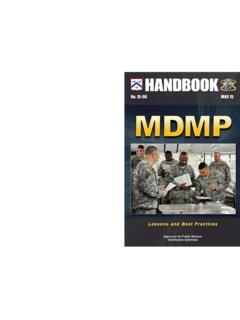Transcription of Comprehensive Lessons Learned
1 ELECTRONIC HEALTH RECORD Comprehensive Lessons Learned Progress Update November 2021 Electronic Health Record Modernization | Comprehensive Lessons Learned Progress Update 1 Summary The VA Electronic Health Record (EHR) is one of the most complex and transformational endeavors in the Department's history. EHR implementation challenges were documented in the Comprehensive Lessons Learned Report submitted to Congress following this year's Strategic Review. This update describes the progress that has been made toward improving the Veteran experience; ensuring patient safety; providing enhanced training to our frontline employees; building confidence at VA sites; implementing organizational and program improvements; improving operational efficiencies; strengthening the efficacy of governance; and improving data management for employees and Veterans. Deploying a new EHR is a clinical and operational transformation that can be highly disruptive. Therefore, under the direction of the Deputy Secretary, VA is refining EHR governance and management structures to establish additional rigor, oversight, and collaboration.
2 A change management strategy combined with organizational restructuring and an enhanced governance model ensures a more collaborative partnership and integration of the EHR deployments. Further details on these refinements are included in this report. The most significant structural change to date is the increased engagement of the Veterans Health Administration (VHA) through the expansion of the Functional Champion role and its associated team. Going forward, the role of the Functional Champion will be greatly expanded to ensure appropriate and sustained clinical involvement. In addition, the Office of the Functional Champion, along with an expanded and well-trained local informatics staff, will help bridge any divides between IT, the EHR vendor, and the care delivery teams to ensure that the needs of the practicing clinicians and support staff are met. VA remains committed to the Mann-Grandstaff implementation and leveraging the Lessons we Learned during Mann-Grandstaff to help us deploy the modern integrated health record system Veterans deserve.
3 In addition, VA continues to develop the EHR long-range deployment schedule using experiential adjustments, readiness assessments, and additional information regarding life cycle costs. Our relationships with DoD and Cerner, of course, are critical to our success. I appreciate Congress's continued support and shared commitment to serving Veterans. Successful deployment of a modern EHR is a key component in the continued delivery of lifetime, world-class health care and benefits for Veterans. Moreover, we have an opportunity to set the standard for health care writ large. With your support, VA, in coordination with DoD and Cerner, as our primary contractor, continues to update and refine the EHR implementation process to ensure it delivers the excellence Veterans expect from VA. -Donald M. Remy Deputy Secretary, Dept of Veterans Affairs Snapshot Introducing an EHR training environment (Sim-EHR), formerly known as the sandbox to better train and familiarize clinicians with the new EHR.
4 Enhanced the readiness checklist and updated the EHR deployment schedule for FY22-FY24 after assessing risks and determining an optimal deployment site sequence within a VISN. Assessing the Patient Portal to identify the best approach to improve access, outcomes, and experience for Veterans seeking care and prescription refills. Planned a December 2021 Safety Summit to review VA s strategy for national/VISN/and local-level clinical and informatics collaboration. Addressing issues identified during the Mann-Grandstaff implementation through training, configuration changes, policy changes, or enhancement requests to improve the Clinician and Veteran Experience. Designed and implementing our new management and governance structure to increase collaboration and integration of subject matter expertise across VA. Finalized a data strategy that implements joint DoD/VA EHR Data Management. This progress update outlines the rigorous approach VA is taking to address issues and deliver a modern, fully interoperable, and integrated health record to support optimal health and well-being of Veterans.
5 Electronic Health Record Modernization | Comprehensive Lessons Learned Report 2 Table of Contents Summary .. 1 Snapshot .. 1 EHRM Status Dashboard: Key Updates .. 3 Implementing Organizational & Program Improvements .. 5 Making Governance Effective .. 7 Deployment Schedule .. 9 Electronic Health Record Modernization | Comprehensive Lessons Learned Report 3 EHRM Status Dashboard: Key Updates Improving the Veteran Experience Progress: Streamlined single sign-on handoff between and MyVA Health to reduce errors and improve Veteran use. VA launched a flagship mobile application for iOS and Android that allows Veterans to access health and benefits services in a single app and is expanding functionality to include users at Mann-Grandstaff in Spokane. Added a provider filter to improve Veteran message reminders and restrict erroneous messaging. If a Veteran wants to send a single secure message with multiple Rx's, they can enter Rx information directly in a blank message, as is done in My HealtheVet.
6 Way Forward: Leveraging APIs to improve integration with mobile apps; legacy Rx and Direct Secure Messaging APIs to enable Veterans at EHRM sites to message providers at VistA sites and refill/renew Rx from VistA sites within MyVA Health. Ensuring Patient Safety Progress: Evaluated all patient safety issues raised during Mann-Grandstaff implementation and identified mitigations to apply in future sites. Drafted a strategy for national/VISN/and local-level clinical and informatics team collaboration on safety incident engagement. Introducing an enhanced Sim-EHR" environment that includes expanded team-based exercises in VISN 10 to train and familiarize clinicians with the new EHR. Handling identity management and data migration issues through the dual EHR data management and analytics strategy. Way Forward: Safety Summit scheduled for December 2021 to review safety incident engagement process. Expand capabilities in Sim-EHR. Providing Extended Training toFrontline Employees Progress: Implemented an EHR training environment designed to optimize the skill of staff using Cerner EHR.
7 Established robust implementation and engagement strategies designed to increase skill and mastery of staff. Team exercises and Super Users were incorporated. An evaluation framework is in place to continuously assess satisfaction, effectiveness, and outcomes of training. Expanded training curriculum to support revenue cycle training, including diagnostic coding and complete documentation. Way Forward: Training will incorporate Lessons Learned from future site visits and includes providing appropriate translational Vista-to-Cerner practices. Developing a sustainment training plan. Building Confidence at VA Sites Progress: VA and Cerner are working together to establish leadership engagement activities that provide awareness of the complexities of transitioning to a new EHR and improve staff guidance. Site readiness decisions are made using a Readiness Checklist with metrics that include leadership, informatics, training, safety processes, high-reliability processes, and infrastructure.
8 Way Forward: Evaluate deployment success at sites using operational metrics such as access times, appointment data, prescription data, revenue collection, clinician productivity, care coordination, system/network performance, and Veteran Portal usage. Establish a centralized document repository for training and change management artifacts. Build a Comprehensive communication strategy for facilities, VISNs, and VHA. Electronic Health Record Modernization | Comprehensive Lessons Learned Report 4 Detailed status reports on each focus area can be found in the attached supporting documentation. EHRM Status Dashboard: Key Updates Implementing Organizational &Program Improvements Progress: VA is implementing a new management structure that provides integration, improved communications, and clear roles and responsibilities for all stakeholders. Way Forward: The schedule and risk management processes are under review, and improvements identified. The new governance will provide requisite oversight.
9 We are using a site readiness risk profile to determine sequencing of facilities within a VISN and to anticipate and be better prepared to address issues, while aggressively working to revise the full deployment schedule. VA contracted with the Institute for Defense Analyses to prepare an independent life cycle cost estimate. Kick-off meeting was October 13, 2021. The full report is due NLT 12 months after kick-off. Improving Operational Efficiencies Progress: Conducted current-state end-to-end process and workflow assessments for a Comprehensive set of clinical and business domains, at sites in VISNs 10, 12, and 20. Enhanced bidirectional interface between Cerner Remedy and VA ServiceNow to include incident and change tickets. Process is in place to receive, categorize, analyze root causes , implement sustainable solutions, and prioritize with clinical inputs. Way Forward: Codify an enterprise operating model with standard roles, role and team-based testing, training, and change management.
10 Reduce redundancy at sites by streamlining user role assignment processes. Evaluate deployment success such as access times, appointment data, prescription data, revenue collection, clinician productivity, care coordination, system/network performance, and Veteran Portal usage. Making Governance Effective Progress: Established unified governance through an EHRM Integration Council combined with existing VA governance structure. The Council will provide an integrated voice for data-driven and time-sensitive decision making to support EHRM goals and objectives. This includes integration with other priority initiatives. Applying an enterprise integrated strategic management framework to conduct Operational Management Reviews chaired by the Deputy Secretary. Way Forward: The EHRM Integration Council will approach acquisition, finance, functional, technical, and change management holistically and will make sure that all key stakeholder views are captured, increase accountability and transparency, and promote data-driven decision making.
